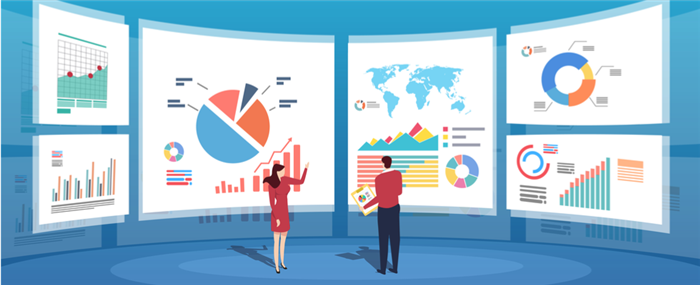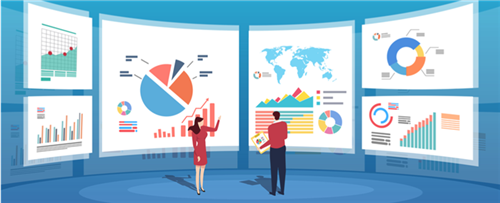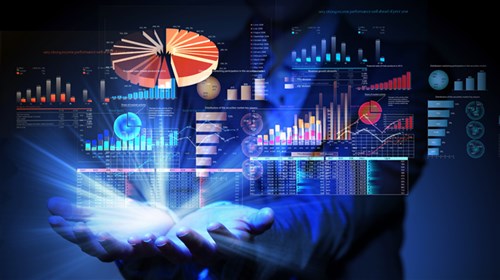
Data has forever disrupted how we interact with machines and communicate with individuals in the past decade. Globally, about 2.5 quintillion bytes of data are generated every day, made up of YouTube videos, emails, text messages and multimedia messages. Both small and large enterprises today have enormous volumes of data inflow. Most of this data is only as valuable as the insights that these businesses can glean from it. This is where data analysts become relevant. A data analyst analyses and interprets statistical data, transforming it into actionable insights that can aid in real-time business decision-making.
Businesses today are becoming more and more dependent on datasets and insights. Insights help key decision-makers to make data-driven decisions such as which markets they should venture into, which products they should produce more, which investments will pay off and the customers they should target. Data also helps businesses in identifying opportunity areas that must be addressed.
Consequently, data analysis is among the most in-demand roles in the world today. Data analysts are being headhunted by the largest businesses across the world. If you are interested in a career that will withstand the disruptions expected in the coming decade, this is an opportunity you wouldn’t want to miss.
A data analyst is an integral part of an organization. They have a lot of responsibilities, from solving challenges using data to finding insights that support decision-making. However, their primary responsibilities can be summed up in these points.
- Identify the kind of data you want to analyze
- Gather the data
- Clean and prepare the data for analysis
- Analyze the data
- Interpret the analysis received to find meaningful insights
Data analysts are also responsible for communicating their findings to the stakeholders/team members. They do this using visualizations, such as charts, to make it easier for people to grasp the technical points.
Types of Data Analytics
In today’s world, data analytics is the key to the success of an organization. If an organization can successfully analyze the data and use it to strengthen its business activities, it can grow significantly.
There are many different types of data analytics. Here, we have discussed the four primary types of data analytics.
Descriptive analytics
“What happened?”
That is the question descriptive analytics answers.
Descriptive analytics forms the basis of other types of analytics. In simple terms, it refers to interpreting the historical data gathered and using it to understand the different changes. It uses historical data to make comparisons.
The most common descriptive analytics include the number of users, year-over-year pricing changes, etc. Descriptive analytics involves using raw data to reach meaningful conclusions. It draws a picture of what happened and compares it with other similar periods to determine the differences. Nowadays, data analysts use descriptive analytics with predictive and prescriptive analytics.
Diagnostic analytics
“Why did this happen?”
That is the question diagnostic analytics sought to answer. It is one of the first steps in an organization’s data analysis. It is focused on identifying patterns by comparing coexisting trends. It chronicles what has already happened.
The most common diagnostic analytics techniques used involve data discovery, data mining, correlations, and drill-down. If you are trying to find the root cause of an issue, diagnostic analytics is the perfect tool.
Predictive analytics
“What might happen in the future?”
As the name suggests, predictive analytics predicts and forecasts future trends and events. The idea is to analyze historical data, understand the trends, and make informed predictions.
Predictive analytics uses machine learning, data mining techniques, and statistical modeling to make predictions. The benefits of prediction include improving operational efficiencies, reducing risks, and making better decisions. It is used for fraud detection, marketing, and human resources. Some popular predictive analytics tools include decision trees, regression, cluster models, and neural networks.
Prescriptive analytics
“What should we do next?”
Prescriptive analytics is concerned with the next step an organization should take. It accounts for all scenarios, available resources, and present performance to offer the possible next steps. Prescriptive analytics is the complete opposite of descriptive analytics.
Prescriptive analytics use machine learning and artificial technology to help organizations make data-backed decisions. When used properly, it can also help in fraud prevention, risk limiting, and goal achievement.
What Tools Do Data Analysts Use?
Data analysts use multiple tools in the course of their jobs. Here are the tools you must know if you are looking to join the field.
Microsoft Excel
Microsoft Excel is one of the most popular tools data analysts use. It is a spreadsheet software mostly used for data wrangling and reporting. It has superb features, functions, and plug-ins that make it essential in almost every field.
The only cons of this tool are that it doesn’t run very well with big datasets. However, despite that, you must be familiar with all its formulas and features.
Python
Python is an open-sourced programming language. It is highly versatile, easy to learn, and has thousands of free libraries, making it popular among data analysts. Libraries like Matplotlib are brilliant for data visualization and reporting, while NumPy is superb in streamlining computational tasks.
The only disadvantage of Python is that it is slower than other programming languages. But its benefits outweigh its cons, making it essential for all data analysts.
Microsoft Power BI
Microsoft Power BI is a business analytics tool for data visualization, predictive analytics, and many other things. It was initially introduced as an Excel plug-in but quickly became a standalone tool. Power BI allows data analysts to create interactive reports and dashboards. It seamlessly connects with Excel, SQL servers, text files, and other useful tools. The tool is regularly updated to keep up with the changing requirements.
One of the disadvantages of Power BI is that it has a clunk user interface and has limited data in the free version.
Tableau
Tableau is a data visualization tool mostly used for creating interactive dashboards and worksheets. You don’t need to have coding experience to use Tableau. It is incredibly easy to use and has great visualizations. It can be used on mobile as well.
Tableau, however, lacks data pre-processing and cannot be used for building complex calculations. Despite this, Tableau’s excellent visualizations make it popular among data analysts.
Jupyter Notebook
Jupyter Notebook is an open-sourced interactive authoring software. It is used for sharing codes, presenting results, and developing tutorials. You can also use Jupyter Notebook to create interactive documents with live code, visualizations, and narrative texts.
It supports more than 40 languages and can be integrated with big data analysis tools easily. However, there are better options for collaboration, and you have to provide all extra assets since the tool is not self-contained.
Apache Spark
Apache Spark is a data processing framework for big data and machine learning. It helps data analysts process huge data sets quickly and accurately. It is easy to use and exceptionally fast. Other tools like Hadoop cannot compare with Spark in terms of speed. However, since it lacks a file management system, it is typically integrated with Hadoop.
Statistical Analysis System (SAS)
SAS is a statistical software suite used for business intelligence and predictive analysis. It includes reporting, data mining, and customer profiling. SAS is robust and versatile, and suitable for big corporations. SAS is an expensive software that requires different levels of expertise. New and better modules are regularly added as per customer demands in SAS.
Job Description for Data Analyst Professionals:
Are you looking to take up a data analyst role in your career? Take a look at some responsibilities that this role comes with.
- Use data analysis tools for data extraction from various data sources.
- Remove wrong or corrupt data.
- Perform quality analysis tests on data.
- Manage and develop databases.
- Create database processes and systems to manage data.
- Filter existing data based on the requirements of various stakeholders.
- Use statistical tools and data analysis to predict market trends and share actionable insights.
- Prepare detailed reports based on analysed data to forecast predictions and trends.
- Work with various members of the team to stay updated on data management systems and processes. This includes the technical, operations, product and engineering teams.
- Manage Exploratory Data Analysis projects and identify patterns.
- Understand MS Excel thoroughly along with Macros and VBA.
- Be proficient in statistical tools such as SAS and SPSS along with various other tools depending on project needs.
Key Skills a Data Analyst Should Have:
- Collecting, measuring, organising and analysing data requires strong mathematical skills
- Understanding of SQL, R, Oracle, Python and other programming languages
- Technical experience working with data models, database design development, segmentation and data mining techniques
- Experience with reporting package handling, including databases, business objects and programming (XML, ETL or JavaScript frameworks)
- In-depth understanding of statistical packages and statistics used to analyse datasets.
- Fluent with the workings of platforms for data processing, such as Apache Spark and Hadoop
- Data visualisation software knowledge including Qlik and Tableau
- Knowing how to apply and create accurate algorithms for datasets to identify solutions
- Problem-solving capabilities
- Attention to fine details
- Solid understanding of report writing, making presentations and querying
- Ability to work in a team
- Strong written and verbal communication skills
- Industry experience specific to data analysis
Qualifications of a Data Analyst:
To become a successful data analyst, technical experience alone is not enough. Earlier, requirements included an undergraduate degree in an analytical or statistical subject like statistics, mathematics or economics. Even today, students with this background have an edge over the competition. Alternatively, you could also choose a postgraduate degree or a skill-based certification. Skill-based certifications have become immensely popular these days as they cover all data analyst roles and responsibilities.
In addition to your technical skills, you also need soft skills like:
- Critical thinking capabilities
- Presentation and communication skills
- Using a logical and systematic approach to solve problems
- Team skills
- Creativity
Data Analyst and Related Roles - Salaries:
Data analyst is just one of the roles in the vast data analytics industry. Take a look at the top job roles that use data analytics. The salaries provided have been shared from LinkedIn (USA) and Glassdoor (India).
Data Analyst - USD 41,600 - 93,600 / Rs. 3,00,000 - 12,00,000
Analytics Manager - USD 78,000 - 150,000 / Rs. 9,00,000 - 31,00,000
Business Analyst - USD 50,000 - 97,200 / Rs. 3,00,000 - 15,00,000
Data Architect - USD 80,200 - 170,000 / Rs. 11,00,000 - 34,00,000
Data Engineer - USD 65,000 - 140,000 / Rs. 4,00,000 - 19,00,000
Database Administrator - USD 48,000 - 120,000 / Rs. 3,00,000 - 15,00,000
Data Manager - USD 41,600 - 144,000 / Rs. 3,00,000 - 30,00,000
Statistician - USD 55,000 - 128,000 / Rs. 3,00,000 - 19,00,000
Research Analyst - USD 41,600 - 85,000 / Rs. 2,00,000 - 9,00,000
Research Scientist - USD 60,000 - 160,000 / Rs. 4,00,000 - 28,00,000
All of the figures given above provide the approximate salary range that is accepted as the standard across most data analytics companies. They vary based on location, experience, organisation and skills among other factors. There are huge opportunities for growth and easy ways to reach new heights through several role-based certification exams.
You May Also Like: What Does a Data Analyst Do? 2022 Career Guide
The Difference Between Data Analysis, Data Science and Business Analysis:
Several roles require the same or similar skill sets. Three such roles are a data analyst, business analyst and data scientist. However, their primary differences can be seen in how each role uses data.
- Data analysts serve as gatekeepers for enterprise data. Their efforts allow even non-technical stakeholders to interpret complex datasets and make strategic data-driven decisions. This role is highly technical and demands a complete degree in data analytics, science, computer modelling or mathematics.
- Business analysts play a more strategic role. They focus on utilising data that data analysts uncover for problem identification and solution proposals. Generally, business analysts have degrees in economics, business administration or finance.
- Data scientists enhance the data visualisations that data analysts create by going a step higher. They go through the data in an attempt to find weaknesses, opportunities or even trends within an enterprise. Data scientists also require a degree or background in computer science or mathematics, besides human behaviour studies that help in making educated predictions.
In small data companies and new startups, data analysts generally take up some of the responsibilities that usually are assigned to data scientists. This includes decision-making or predictive modelling, for example.
Also Read: Data Analyst Salary in United States
Why Should You Choose a Data Analytics Certification Course on Koenig:
- Koenig brings you data analytics courses and certifications from Cloudera , Microsoft and other leading vendors in one place.
- Get expert data analysts as trainers with real-world experience that helps candidates understand how important data analytics is for streamlining business processes.
- The course study material for data analytics is curated by experts in the industry with holistic knowledge regarding data analysis.
- Join live online Data Analytics training from Koenig which is an accredited partner for training to both Cloudera and Microsoft.
- Get convenient schedules for students and working professionals allowing for 4-hour and 8-hour training slots for your Data Analytics course.
- Earn an industry-acclaimed certification on completing a Data Analytics course from Koenig.
- Future-proof your career with Data Analytics and start a career journey that is both rewarding and enriching.
We are now in the new normal, where most consumers have moved online and data is generated from a multitude of sources. Fill the gap in the market and expand your horizons by enrolling in a Data Analytics certification course today.





(1)(1).pngM.jpg)

COMMENT